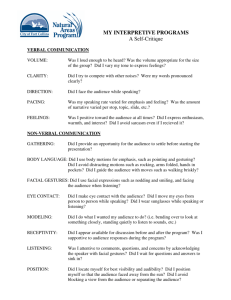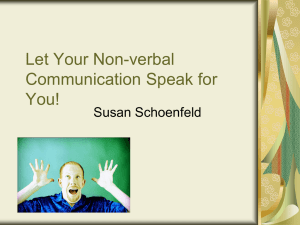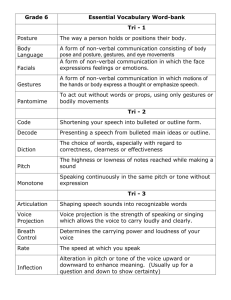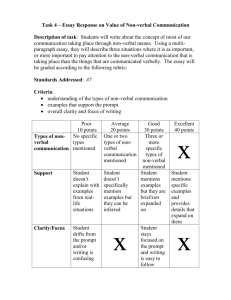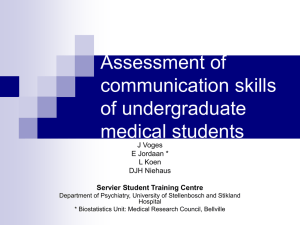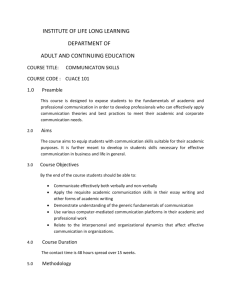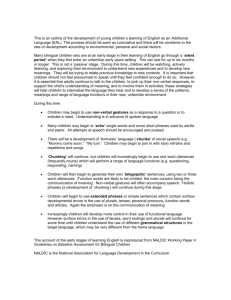Document
advertisement
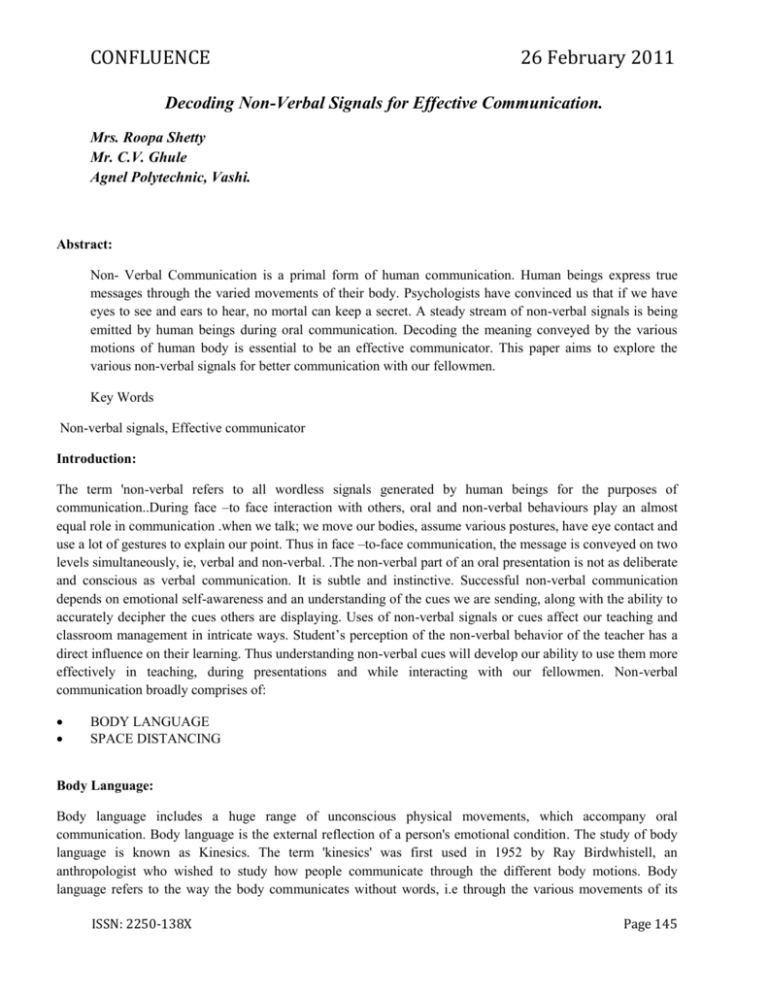
CONFLUENCE 26 February 2011 Decoding Non-Verbal Signals for Effective Communication. Mrs. Roopa Shetty Mr. C.V. Ghule Agnel Polytechnic, Vashi. Abstract: Non- Verbal Communication is a primal form of human communication. Human beings express true messages through the varied movements of their body. Psychologists have convinced us that if we have eyes to see and ears to hear, no mortal can keep a secret. A steady stream of non-verbal signals is being emitted by human beings during oral communication. Decoding the meaning conveyed by the various motions of human body is essential to be an effective communicator. This paper aims to explore the various non-verbal signals for better communication with our fellowmen. Key Words Non-verbal signals, Effective communicator Introduction: The term 'non-verbal refers to all wordless signals generated by human beings for the purposes of communication..During face –to face interaction with others, oral and non-verbal behaviours play an almost equal role in communication .when we talk; we move our bodies, assume various postures, have eye contact and use a lot of gestures to explain our point. Thus in face –to-face communication, the message is conveyed on two levels simultaneously, ie, verbal and non-verbal. .The non-verbal part of an oral presentation is not as deliberate and conscious as verbal communication. It is subtle and instinctive. Successful non-verbal communication depends on emotional self-awareness and an understanding of the cues we are sending, along with the ability to accurately decipher the cues others are displaying. Uses of non-verbal signals or cues affect our teaching and classroom management in intricate ways. Student’s perception of the non-verbal behavior of the teacher has a direct influence on their learning. Thus understanding non-verbal cues will develop our ability to use them more effectively in teaching, during presentations and while interacting with our fellowmen. Non-verbal communication broadly comprises of: BODY LANGUAGE SPACE DISTANCING Body Language: Body language includes a huge range of unconscious physical movements, which accompany oral communication. Body language is the external reflection of a person's emotional condition. The study of body language is known as Kinesics. The term 'kinesics' was first used in 1952 by Ray Birdwhistell, an anthropologist who wished to study how people communicate through the different body motions. Body language refers to the way the body communicates without words, i.e through the various movements of its ISSN: 2250-138X Page 145 CONFLUENCE 26 February 2011 parts. Some bodily movements are deliberately intended to communicate. Sometimes people send confusing or negative non-verbal signals without even knowing it. Thus it becomes difficult to be decoded; however, a broad understanding of body language is one way to understanding the real opinion of others. Body language comprises of gestures, facial expressions, eye contact, posture, personal appearance and spacing. It is important to know more about these features of body language, because in face –to –face communication only 35% of the meaning is derived from speech, while more than 65% of meaning is derived from body language. People react strongly to what they see. Gestures: Gestures are the movement made by hands, arms, shoulders, head and torso. They are an important part of body language. The language of gestures, unlike facial expressions and posture varies from region to region. Gestures are also more numerous than any form of non-verbal communication, and the meanings attached to them diverse. It has been observed that there are as many as 700,000 varied hand gestures alone, and the meanings derived from them may vary from individual to individual. We express ourselves with gestures often without thinking. Single gestures may combine to form complex patterns. Gestures should not distract the attention of the observer from the message. It should be natural and spontaneous. It should be closely coordinated with speech. Supporting gestures, such as nodding while somebody is talking creates empathy. A lively and animated teaching style using suitable gestures captures student’s attention, makes the subject matter more interesting,facilitates learning provides a bit of entertainment. The teacher who fails to gesture while speaking may be perceived as boring, stiff and unanimated. Gestures can be categorized as either speech independent or speech related. Gestures can be divided into the following types.— Enumerative-numbers Descriptive-size of the objects Symbolic-abstract concepts Locative-location of an object Emphatic-emphasis Facial Expressions: The face is the most expressive part of the body and conveys true feelings. It is more highly developed as an organ of expression in humans, than any other animal. Feelings of love, happiness, mirth, surprise, anger, determination, contempt, disgust, fear and suffering are revealed through facial expression. Unlike some forms of non-verbal communication, facial expressions are universal. We can recognize certain feelings or attitudes. A smile stands for friendliness, a frown for dis –content, raised eyebrows for Disbelief and tight jaw muscles for antagonism. Smiling is a powerful cue that transmits happiness, warmth, friendliness, and liking. Thus if teacher smiles frequently,he/she will be perceived as more likable, friendly and approachable. Smiling is contagious and students will react favourably and learn more. With enthusiastic facial expression the teacher can arouse the interest of the students in the subject. A teacher can create the desired effect by accompanying verbal communication with appropriate facial expression though there are only five basic facial expressions, we can have many blends. Therefore it becomes difficult to interpret. The five basic facial expressions are: Inhibited-restricted and stolid ISSN: 2250-138X Page 146 CONFLUENCE 26 February 2011 Uninhibited-spontaneous and impetuous Substitute-happy with a long face Frozen-no change in expression Blank-no expression at all Eye Contact: The study of the role of eyes in non-verbal communication is scientifically termed ‘oculesics’. The eyes are considered to be the windows of the soul. It can speak volumes. By looking into the eyes of the speaker, we can find out the truthfulness of his speech and feelings. Eye contact is a direct and powerful form of non-verbal communication. It can indicate interest, attention,, and involvement. Through the eyes we can collect information, and it can also be a rich source of feedback. When there is continuous eye contact between the speaker and the listener, there can be effective communication. While addressing a large group of people, a good speaker should look at all sections of the audience .If a part of the audience are ignored it will lose interest in what is being communicated. Teachers should make and establish eye contact with all the students to gain the trust and make a positive impression. Before beginning to teach, teachers should scan the classroom and ensure that all students are attentive. When the class is very noisy with the students talking, an effective non-verbal cue is to stand still and stare at the class, and wait patiently and calmly until the class becomes silent. Posture: The speaker’s bodily stance can convey a great deal of information during face-to-face communication. Posture refers to the way a person stands, sits, walks or sleeps. This can communicate a rich variety of messages. It can help determine a speaker’s degree of attention or involvement. In face –to-face communication, one’s posture can tell us of the kind of relation between two people or the difference in their status. We can judge the speaker by the way they position their hands, head, legs and other parts of the body. The walk can reveal, whether the person is confident, strong and enthusiastic or diffident, weak and dull. An effective communicator addressing a group should stand erect and exude an air of confidence. Drooping shoulders and slouching should be avoided during any interaction. To keep the class under control, the teacher must have a confident gait and an erect posture. Slumped posture portrays low spirit. An open posture with arms spread in a relaxed manner shows confidence and enthusiasm. Crossed arms are seen as a negative stand and could put students on the defensive. Personal Appearance: The speaker is seen before he is heard, therefore the first impact on the audience is created by his physical appearance. A pleasant appearance may encourage the audience to be receptive to the message .on the other hand, an untidy appearance may put the audience into resistant attitude. A person's clothes, shoes and hair style can tell us of his nature. The accessories he carries can signify his class and status in society. The way people handle cigarettes, pipes, canes, glasses also suggest their personality. A good teacher should be elegantly dressed. Clean, well ironed formal attire is desirable. Hair should be neatly combed and shoes well polished. Accessories that would distract the students’ attention should never be carried to class. Space Distancing: ISSN: 2250-138X Page 147 CONFLUENCE 26 February 2011 Proximics is the scientific term for the study of space distancing. It refers to the spatial distance maintained with others while communicating. A comfortable distance is required between the speaker and the listener during a communication situation. Unless the communicants are emotionally close to each other, there needs to be an area of personal territory around the communicator. Teachers should maintain a comfortable distance for interaction with students.Usually in large classrooms there is too much distance. To counteract this ,teachers should move around the classroom. Increasing proximity enables teachers to make better eyecontact and know students well. In social interactions, normally a 4 to 12 feet range is maintained between people. Space distancing varies from culture to culture. Hence a good communicator should know the acceptable distance among communicants preferred in different countries. Functions of Non-Verbal Communication: o To express interpersonal attitudes o To express feelings. o To reinforce spoken communication. o To present one’s personality. o To greet people. o To substitute for verbal messages. o To contradict verbal messages. o To regulate verbal behavior. Advantages of using Non_Verbal cues in Classroom Management: 1. Using non-verbal techniques in the classroom reduces the time spent in disciplining the class and allows the teacher to focus on curriculum. The teacher will gain more time in clearing the doubts that arise in students and hence an effective class. 2. When teachers match the verbal message with the non-verbal, students are able to understand the message clearly. Congruent communication leads to increased control, which means, less management problems in the class. 3. Using non-verbal techniques in the classroom allows a teacher to manage from influence, not power. Although obedience can often be gained from a student when managing from power, managing through influence creates a safer and happier class environment. 4. Managing students with non-verbal techniques preserves relationships. Teachers are able to separate the person from the behavior and most negative interactions are avoided. Teachers report less stress after incorporating non-verbal classroom management skills into their teaching. 5. Cultural differences often lead to communication problems in the classroom. Managing non-verbally creates a common language amongst all students in the class. A teacher who manages through non-verbal cues is seen as fair. Conclusion: It is said, “Actions speak louder than words”. In the context of classroom management it is very true. Teachers who were most successful in their classroom management were those who systematically used non-verbal cues ISSN: 2250-138X Page 148 CONFLUENCE 26 February 2011 .Non-verbal messages are an essential component of communication in the teaching process. According to research, 82% of a teacher’s communication is non-verbal. What a teacher does makes much bigger impact than what a teacher says. The area of non-verbal communication has grown speedily over the last few decades, and it has found applications in business, media, medicine, psychology, education and many other fields, which requires interpersonal and group dynamics. If the people involved in communication have the ability to decode nonverbal messages correctly effective communication is possible. The study of non-verbal behaviors can decrease misunderstandings between people, since they gain the knowledge of a range of subtle behaviors .Those sending messages can understand themselves better and exert greater care in their way of speaking. those receiving the message will also learn to better understand their responses. The non-verbal code though universal in nature, has been greatly influenced by the culture prevailing in the region. Gestures personal appearance and space distancing varies from culture to culture. Therefore care should be taken in using the suitable codes in cross cultural communication contexts. All along our culture has under rated the value of nonverbal communication during oral face to face communication situations. The injunction had been, “Hear what I say , and don't notice the way I say it”. Since these factors are ignored in school and homes, the task of incorporating deliberate sensitivity to non-verbal communication is difficult. Hence, teachers should acquaint students with nuances of this vital dimension of decoding non-verbal signals in communication. References: o Vicki Ritts & James R. Stein : Six Ways to Improve Your Non-verbal Communications. o T.E. Editor (British council) o Jennifer Wang o Susan M. Heathfield : Listen with Your Eyes. o Steve Darn : Aspects of Non-verbal Communication o o Robert Hiller :Communicate Clearly,A Dorling Kindersley book,2008 Meenakshi Raman & Sangeeta Sharma :Technical Communication-Principles and Practice,oxford University Press,2004 ; Non-verbal Communication : Seven Non-verbal Cues and what they Mean. ------------ ISSN: 2250-138X Page 149
